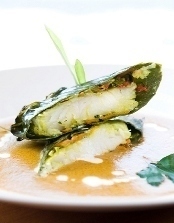
|
|


Though it is time-consuming to make, there was nothing I loved more than eating warm chapatti in Kenya. I couldn't get enough of the bulgogi in Korea. And in Australia, I was surprised to find that I like crocodile soup. Food is an integral part of a culture. Countries, regions and even cities are home to flavors that help define what makes them distinct. It's easy to get caught up in the list of tourist must-dos in a new destination and skip this equally important travel detail. From the Leaning Tower of Pisa in Italy to the Sydney Opera House in Australia, we tend to jump around city maps, marking off places we've visited and things we've seen as we rush from site to site. The challenge of traveling is to slow down-and this is especially true when it comes to food. Food has a cultural context, a history and a story, and provides a wealth of information about the people who cook it. Not only is it part of the experience, it often IS the experience. Like language, music and art, food is a way in which people express their culture. Is it really any surprise that we say we yearn for a "taste" of other cultures and that, when we visit, we find some places have a unique "flavor" found nowhere else? When I lived with a host family in Kenya, women frequently gathered in my mama's kitchen to cook chapatti. The tortilla-like bread was tedious to make, but when the women got together to prepare the dish, it was as much about socializing and spending time with one another as it was about feeding their families. When I helped prepare the chapatti with them, and when my host family ate together, I found food to be an easy way to connect with locals. Once you start talking about the common ground of eating, the doors open for further conversation on countless topics. Another Kenyan staple, ugali-a sticky polenta dish-is served with nearly every meal. Though I find it a bit tasteless, I happily put some on my plate as my ticket to being included in the cultural exchange that happened over the course of a meal. In many countries, street food is a great way to sample the local cuisine. Though it is always a good idea to make sure the food you consume is hot and hasn't been sitting out for a long duration of time, there's generally nothing wrong with sampling scorpion in Beijing's food market or roasted ants in Colombia. Ask locals where they like to eat. Strike up a conversation with the vendors. Those experiences-more than anything you bought a ticket for-will truly immerse you in a foreign country. I'm not usually a foodie at home, but when I hit the road, I am always curious about the local food. I admit to not being so fond of delicacies that still look like what they were when they were living, but that doesn't make me any less curious about the traditions. I couldn't stomach the thought of eating cuy-guinea pig-in Peru, but it was interesting to learn that it's a dish eaten on major holidays and special occasions. In Korea, I desperately wanted to like kimchi (a side dish made of fermented cabbage and other vegetables), but despite my many attempts to find a fondness for it, the two of us never found a shared love. And that happens. You won't always like the food you'll encounter on the road, but being open to the experience can mean the difference between seeing a place and understanding a culture. I challenge you … after leaving the Leaning Tower of Pisa, take some time to enjoy gelato or a cappuccino in a café. And don't forget to leave Australia without trying the vegemite. |
Copia Magazine Home --- Contact Us --- Privacy Policy --- Copyright |